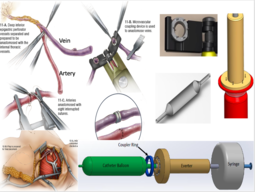Arterial Vessel Joining Method
TECHNOLOGY NUMBER: 6673

OVERVIEW
A device for arterial vessel fixation during surgical flap placement- Permits vessel eversion and joining through the use of a coupler ring
- Decreases the need for surgical training and time spent on procedures
BACKGROUND
Tissue transfers from one site of a patient’s body to another (flaps) and from a deceased donor to another (transplants) provide a means completing reproductive surgery. The goals of reconstructive surgery include repair of damaged tissues, recovery of appearance, or restoration of function and feeling. The most common clinical circumstances that lead to tissue transfer or transplant include trauma, thermal burns, cancer resection, or injury. Free flap tissue transfer first involves removal of skin, fat, muscle, nerves, and perhaps even bone from the donor site followed by reattachment at the recipient site. Surgical reattachment of veins and arteries to establish circulation often requires microanastamosis procedures that may prove labor intensive and expensive. Furthermore, the small diameter of most vessels requires specialized surgical training and the use of specialized equipment such as a surgical microscope to complete. As such, a need exists for an improved method to facilitate microanastamosis procedures during flap placement.
INNOVATION
Researchers have created a device that allows for arterial vessel fixation as well as arterial eversion to optimize the ability to secure to vessels together. This design is comprised of three main components: 1) a medical syringe, 2) a catheter balloon, and 3) an arterial everter, which rolls the vessel back on itself to form a cuff that exposes the endothelium. During the procedure the syringe is screwed into the designated inflation port of the catheter balloon, and then the everter is slid over the catheter balloon. The artery is then pulled through a coupler ring, and then the catheter balloon is inserted inside the artery. Once the catheter balloon is inserted to the correct length, it is inflated by depressing the syringe plunger. The everter is then slid down the catheter wire, it everts the artery, it pierces the artery wall onto the pins of the coupler ring, and then the vessels are secured.
-
expand_more mode_edit Inventor (12)Aaron FarbergAdeyiza MomohAlbert ShihJeffrey KozlowJeffrey PlottJonathan ZwierKelsey LuibrandKirsten BoelkinsKrishna MahajanMartin SisolakPaul CedernaSebastian Kwon
-
expand_more cloud_download Supporting documents (1)Product brochureArterial Vessel Joining Method.pdf